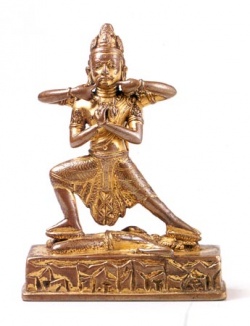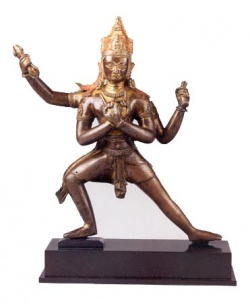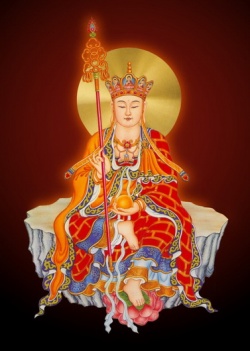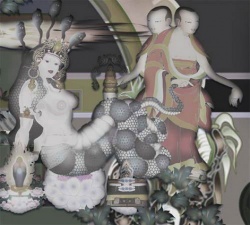Vajra-hum-kara
Vajrahumkara is closely associated with the esoteric deity Trailokyavijaya; the name first appears as an epithet of the latter in early (c. seventh-to eighth-century) esoteric Buddhist texts.
This deity normally has one head with three eyes, bared fangs, yellow flaming hair, and two empty hands, crossed over his chest at wrist level, palm outwards, in the humkara mudra which is a gesture of strength.
The first picture above shows him with four hands, two as described and two holding a thunderbolt and a manuscript respectively. The next one depicts him with the other two hands on each side of his mouth.
In this portrayal, his fearsome expression is enhanced by an unusual modification of a traditional esoteric grimace:
he bites only the right half of his lower lip, exposing the upper teeth;
the left side of his mouth is held in a snarl. Vajrahumkara wears a type of crown that is rarely depicted in sculpture, but resembles the ritual helmets worn by Buddhist priests in Nepal.167 It consists of three tiers: the lower and middle tiers are engraved with a floral motif and separated by a beaded ridge.
Vajra Humkara (Tib.: dor je hung dze).
"Humkara, black [with] one face and two hands. Holding a vajra and bell to the heart in his own gesture. Having slightly bared fangs and three eyes. Yellow hair bristling upwards. Adorned with jewels and snakes. Having a lower garment of tiger skin. Standing in a manner with the left leg extended subduing Bhairava." (Konchog Lhundrub, 1497-1557).
The front sections of both the upper and most of the middle tier have been cut away to provide a platform for the image of Vairocana. Four Tathagatas are depicted at the cardinal points, with Vairocana placed above Aksobhya.
The crown ties, knotted above Vajrahumkara's right ear, drape across his upper right arm; three thick locks of hair fall onto each shoulder.
The Sarvatathagata Tattva Samgraha (STTS), a Sanskrit text which was translated into Tibetan by Rinchen Sangpo (958-1055) and the Indian Sraddhakaravarma, states that Trailokyavijaya is 'specially commissioned, and [is] equipped to perform those necessary tasks the Tathagata cannot perform with only peaceful means'.168
His wrathful appearance, his characteristic gesture (vajrahumkara), and his ritual implements all suggest the extraordinary - if fearsome - powers that he makes available to the adept who seeks to overcome his inner obstacles in the process of spiritual awakening.170
Although depictions of Vajrahumkara/Trailokyavijaya are rare in Tibetan art, a form of this deity does appear in the murals of the Dukhang at Alchi (c. 1200), where his iconography corresponds to descriptions in the STTS.171
He also appears in the murals of the Jampa Lhakhang (Maitreya Temple) in Mustang, datable to about the second quarter of the fifteenth century.172
This powerful copper image has strong artistic ties with Nepal, and stylistic parallels may be drawn with two dated Nepalese works in the Kathmandu Valley.
A necklace, earrings and scarf endings fashioned similarly are to be found on a gilt copper figure of Visnu, perhaps dated 1052.173 Visnu's pedestal is of the type that supports the figure of Vairocana at the top of the Nyingjei Lam Vajrahumkara's crown.
Earrings of similar design are found on a stone image of Uma-Mahesvara, dated 1012 or 1032; Uma's belt is virtually identical with that of Vajrahumkara.174 The high copper content of the sculpture and its modelling are also strong indications of its affiliations with Nepal.
It is likely, however, that this sculpture was made outside the Kathmandu Valley.
It is significant that the tang beneath the left foot bears the Tibetan inscription ba tsi ra hung ka ra, a phonetic rendering of the deity's Sanskrit name.
Although there is no firm evidence that the inscription was written at the time the image was made (thereby providing an invaluable clue as to its provenance),
it should be noted that accretions similar to those on the rest of the statue may be observed in and around the incised letters on the tang. This would indicate that the inscription is at least not a recent addition to the statue.
Despite the stylistic affiliations with Nepalese works, its deviations therefrom and the presence of the Tibetan inscription are indications that this sculpture may well have been made for a Tibetan patron.
A c. eleventh-to twelfth-century date is ascribed to this work on the grounds of its close stylistic parallels with the dated works mentioned above. (cat. pl. 10)
166. Linrothe (1999), p. 190; Mallmann (1975), pp. 381-2. A tang under the left foot is inscribed ba tsi ra hung ka ra, a Tibetan transliteration of the Sanskrit 'Vajrahumkara'.
167. See a twelfth-century example in the Los Angeles County Museum of Art, published in Pal (1985), no. S27, p. 106; another example (dated 1145) is in the Mus�e Guimet, See B�guin (1984).
168. Linrothe (1999), p. 186.
169. He holds the diamond scepter (vajra) in his upper right hand and an unidentified implement in his upper left hand. Rob Linrothe has suggested that this image may have been a subsidiary figure in a Trailokyavijaya mandala, in which all subsidiary figures differ only in the attribute held in their left hand. (Personal communication, January 1999)
170. Linrothe (1999), p. 211.
171. As noted by Linrothe (1999), pp. 207-10, figs. 170-2; See also fig. 173 in which a c. twelfth-century image of Trailokyavijaya at Sumda in Ladakh is reproduced.
172. Published in Dowman (1997), fig. 224 and p. 189.
173. Published in Pal (1974), fig. 31. Regarding its date, Pal writes, 'possibly consecrated in the year 1052', but does not elaborate (lbid. , p. 33).
174. Published in Pal(1975), fig. 51. Pal notes on p. 35 that the (separate) pedestal of the image is inscribed, stating that an Uma-Mahes'vara image was consecrated in 1012 (the caption for fig. 51, however, gives a date of 1032).




